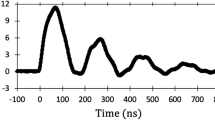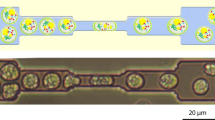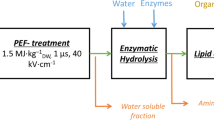Abstract
Treatments with high-voltage electrical discharges (HVED) and high-pressure homogenization (HPH) were studied and compared for the release of ionic components, carbohydrates, proteins, and pigments from microalgae Parachlorella kessleri (P. kessleri). Suspensions (1% w/w) of microalgae were treated by HVED (40 kV/cm, 1–8 ms) or by HPH (400–1200 bar, 1–10 passes). Particle-size distribution (PSD) and microscopic analyses were used to detect the disruption and damage of cells. HVED were very effective for the extraction of ionic cell components and carbohydrates (421 mg/L after 8 ms of the treatment). However, HVED were ineffective for pigments and protein extraction. The concentration of proteins extracted by HVED was just 750 mg/L and did not exceed 15% of the total quantity of proteins. HPH permitted an effective release overall of intracellular compounds from P. kessleri microalgae including a large quantity of proteins, whose release (at 1200 bar) was 4.9 times higher than that obtained by HVED. Consequently, HVED can be used at the first step of the overall extraction process for the selective recovery of low-molecular-weight components. HPH can be then used at the second step for the recovery of remaining cell compounds.







Similar content being viewed by others
References
Gong Y, Hu H, Gao Y et al (2011) Microalgae as platforms for production of recombinant proteins and valuable compounds: progress and prospects. J Ind Microbiol Biotechnol 38:1879–1890
Matos CT, Santos M, Nobre BP, Gouveia L (2013) Nannochloropsis sp. biomass recovery by electro-coagulation for biodiesel and pigment production. Bioresour Technol 134:219–226
Parniakov O, Barba FJ, Grimi N et al (2015) Pulsed electric field and pH assisted selective extraction of intracellular components from microalgae nannochloropsis. Algal Res 8:128–134
Barba FJ (2017) Microalgae and seaweeds for food applications: challenges and perspectives. Food Res Int 99:969
Barba FJ, Grimi N, Vorobiev E (2014) New approaches for the use of non-conventional cell disruption technologies to extract potential food additives and nutraceuticals from microalgae. Food Eng Rev 7:45–62
Poojary MM, Barba FJ, Aliakbarian B et al (2016) Innovative alternative technologies to extract carotenoids from microalgae and seaweeds. Mar Drugs 14:214
Günerken E, d’Hondt E, Eppink MHM et al (2015) Cell disruption for microalgae biorefineries. Biotechnol Adv 33:243–260
Luengo E, Martínez JM, Bordetas A et al (2015) Influence of the treatment medium temperature on lutein extraction assisted by pulsed electric fields from Chlorella vulgaris. Innov Food Sci Emerg Technol 29:15–22
Yap BHJ, Dumsday GJ, Scales PJ, Martin GJO (2015) Energy evaluation of algal cell disruption by high pressure homogenisation. Bioresour Technol 184:280–285
Zhang F, Cheng L-H, Xu X-H et al (2011) Screening of biocompatible organic solvents for enhancement of lipid milking from Nannochloropsis sp. Process Biochem 46:1934–1941
Grimi N, Dubois A, Marchal L et al (2014) Selective extraction from microalgae Nannochloropsis sp. using different methods of cell disruption. Bioresour Technol 153:254–259
Norton T, Sun D-W (2008) Recent advances in the use of high pressure as an effective processing technique in the food industry. Food Bioprocess Technol 1:2–34
Patrignani F, Lanciotti R (2016) Applications of high and ultra high pressure homogenization for food safety. Front Microbiol 7:1132
Mendes-Pinto MM, Raposo MFJ, Bowen J et al (2001) Evaluation of different cell disruption processes on encysted cells of Haematococcus pluvialis: effects on astaxanthin recovery and implications for bio-availability. J Appl Phycol 13:19–24
Carullo D, Abera BD, Casazza AA et al (2018) Effect of pulsed electric fields and high pressure homogenization on the aqueous extraction of intracellular compounds from the microalgae Chlorella vulgaris. Algal Res 31:60–69
Cooney MJ, Young G, Pate R (2011) Bio-oil from photosynthetic microalgae: case study. Bioresour Technol 102:166–177
Balasundaram B, Harrison S, Bracewell DG (2009) Advances in product release strategies and impact on bioprocess design. Trends Biotechnol 27:477–485
Lee AK, Lewis DM, Ashman PJ (2013) Force and energy requirement for microalgal cell disruption: an atomic force microscope evaluation. Bioresour Technol 128:199–206
Boussetta N, Vorobiev E (2014) Extraction of valuable biocompounds assisted by high voltage electrical discharges: a review. Comptes Rendus Chim 17:197–203
Dubois M, Gilles KA, Hamilton JK et al (1956) Colorimetric method for determination of sugars and related substances. Anal Chem 28:350–356
Bradford MM (1976) A rapid and sensitive method for the quantitation of microgram quantities of protein utilizing the principle of protein-dye binding. Anal Biochem 72:248–254
Shynkaryk MV, Lebovka NI, Lanoisellé J-L et al (2009) Electrically-assisted extraction of bio-products using high pressure disruption of yeast cells (Saccharomyces cerevisiae). J Food Eng 92:189–195
Samarasinghe N, Fernando S, Lacey R, Faulkner WB (2012) Algal cell rupture using high pressure homogenization as a prelude to oil extraction. Renew Energy 48:300–308
Spiden EM, Yap BHJ, Hill DRA et al (2013) Quantitative evaluation of the ease of rupture of industrially promising microalgae by high pressure homogenization. Bioresour Technol 140:165–171
Barba FJ, Grimi N, Vorobiev E (2015) Evaluating the potential of cell disruption technologies for green selective extraction of antioxidant compounds from Stevia rebaudiana Bertoni leaves. J Food Eng 149:222–228
Xie Y, Ho S-H, Chen C-NN et al (2016) Disruption of thermo-tolerant Desmodesmus sp. F51 in high pressure homogenization as a prelude to carotenoids extraction. Biochem Eng J 109:243–251
Acknowledgements
Rui Zhang would like to acknowledge the financial support of the China Scholarship Council for thesis fellowship.
Author information
Authors and Affiliations
Corresponding author
Ethics declarations
Conflict of interest
The authors declare that there is no conflict of interest.
Rights and permissions
About this article
Cite this article
Zhang, R., Grimi, N., Marchal, L. et al. Application of high-voltage electrical discharges and high-pressure homogenization for recovery of intracellular compounds from microalgae Parachlorella kessleri. Bioprocess Biosyst Eng 42, 29–36 (2019). https://doi.org/10.1007/s00449-018-2010-4
Received:
Accepted:
Published:
Issue Date:
DOI: https://doi.org/10.1007/s00449-018-2010-4




